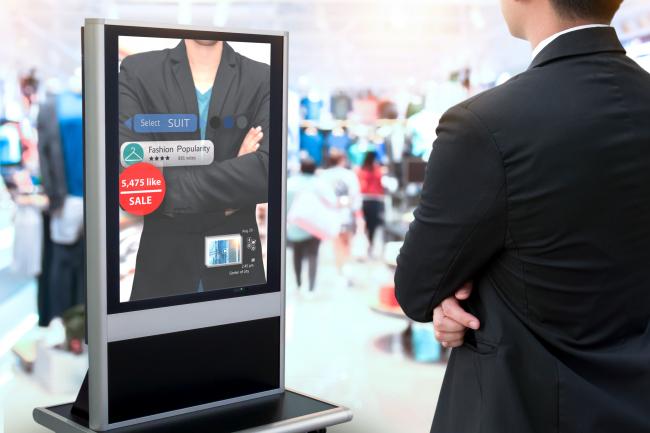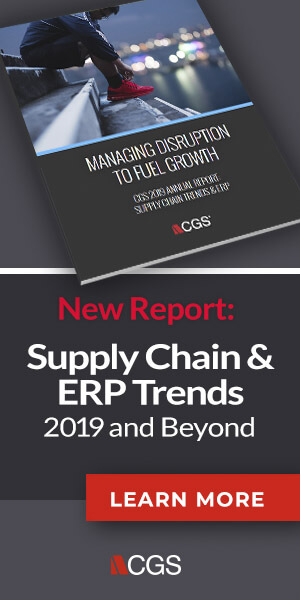About the speaker:
Peter Coffee, VP for Strategic Research at Salesforce has been with Salesforce for 12 years. He works with customers and partners on CIO strategies and emerging technology opportunities. He previously spent eighteen years writing for publications including eWEEK, Computer Language and AI Expert, and worked for ten years as an AI application analyst and desktop computing manager at The Aerospace Corporation and in project management roles for various divisions of Exxon. He has lectured on innovation strategies and AI techniques at Stanford, CalTech, UCLA, Harvard Business School, and the Sloan School of Management at MIT; he advises on curriculum in analytics and "big data" initiatives for three other U.S. universities.
Topics
Winning the Engagement Revolution for Fashion and Footwear Brands and Retailers

6 Key Takeaways from Peter Coffee at the CGS INSIGHT 2019 BlueCherry® User Conference
The CGS annual BlueCherry user group event, INSIGHT 2019, brings together leading experts and decision-makers from across hundreds of major fashion and consumer goods companies to share product updates and exchange ideas on new and exciting ways to fuel business growth. At this year’s three-day event, we had the special privilege of hosting several noteworthy guest speakers such as Bernard Baumohl, the Chief Global Economist at the Economic Outlook Group, Ilse Metchek, President of the California Fashion Association (CFA) and Peter Coffee, Vice President for Strategic Research at Salesforce.
As one of the speakers at INSIGHT 2019, Peter Coffee engaged audience members with his fascinating, data-driven and humorous observations about the retail industry. If you missed it, no need to worry. We’ve captured six key takeaways from his talk that are relevant to the future of every fashion and footwear brand, retailer and manufacturer.
1. The Revolution Will Be Digitized
Nearly every company claims to be a part of the digital revolution, but that’s not realistic. Revolutions are difficult, painful and cause unforeseen disruptions. To truly lead a revolution, organizations need to be willing to look beyond modernization and challenge their traditional beliefs and power bases. They need to realize that in order to survive, they will have to do things they’ve never done before, in ways they had never considered.
This change doesn’t have to be adversarial, rather it simply requires the willingness to evolve beyond the old, outmoded ways of thinking and prepare for continuous transformation. As digitalization rapidly changes the workforce, companies need to adapt quickly and broaden their understanding of the changes taking over their market, their competitors and most importantly, their customers.
2. Prepare to Invert Your Business Models
The future of retail including apparel, fashion and footwear is not going to look like anything we’ve seen before. So be prepared. We’re at a tipping point as we move from an economies-of-scale, mass-production model to something that is more localized, customized and customer-centric. While the previous era of globalization made mass affordability possible, today’s era is marked by new technologies that are primed to serve unique customer demands and deliver personalized experiences. Peter shared the examples of companies such as Guillaume Néry and COMSUBIN, which offer customers exclusive luxury experiences to complement their products.
The luxury market represents those consumers who already live in the future and are key for any company seeking to innovate for the future. Businesses that aren’t going to take the leap and take advantage of being the first mover risk being left behind. Apparel and footwear retailers now face shorter production runs, new manufacturing technologies, localized manufacturing and a rapidly changing consumer demographic. As a result, they can no longer only look to cost advantages when determining their retail strategy.
3. Drive Innovation with Connectivity
Some organizations feel threatened by the idea of change. They fear that the need to change implies that they’ve been on the wrong track. But that’s just not the case. Companies need to remember: “There is nothing worse than doing a wrong thing better.” You may not have been wrong in the past, but are you taking the right steps now? Is your use of new technologies growing at the right pace? Are you making the most of what is available?
The collective connective power in the world has grown from 11 Terabits per second (Tbps) in 2007 to 211 Tbps in 2014, and is expected to reach 1,914 Tbps by 2021. In practical terms, we’ve gone from being able to send every human on Earth, three ring tones a day to now sending them 33,000 ringtones a day. But of course, this isn’t the most effective use of this bandwidth – it’s in the data transactions that it enables. However, despite this growth most traditional industries, such as financial services, have been slow to leverage its full potential.
Better connectivity is not just a matter of speed, it’s an explosion of opportunities for furthering the customer experience. Unfortunately, despite this growing connectivity, 37% of customers feel less connected to companies than two years ago. With 5G just around the corner, fashion and footwear companies will have the opportunity to fix this and enter a new retail ecosystem where the network itself will become an essential participant of the data solutions. This will be fundamentally different from anything we’ve seen before and companies need to face this change with innovation.
4. Broaden Your Customer Demographics
Businesses need to broaden their awareness and empathy for customers across demographics. It’s not enough to only tailor your products and services to millennials and the younger demographic. Customers in their 50s and 60s are a growing market and need to be acknowledged in the retail ecosystem. On average, the majority of older retail consumers are well-educated, smart, active and, more importantly, wield considerable buying power. Similarly, younger consumers are also becoming more self-sufficient and demanding of a higher standard of service and experience in how companies engage with them.
Organizations that falter in this respect, tend to believe that their product defines their brand. So being hip and popular means directing products toward the young, but this is not true. Customers don’t engage with a brand based on its voice and reputation more than they do with its products. In fact, 71% of businesses and 59% of consumers expect companies to provide frequent innovations to their products and services, with 72% of businesses and 64% of consumers having raised their expectations from new products and services. Fashion and footwear brands have the opportunity to truly enhance their business value by focusing on customer experience across demographics with a customer-centric product development process that focuses on creating positive retail experiences that transcend traditional demographics.

5. Transform Customer Service
Customer expectations today are very simple: they want to be recognized and remembered. Unfortunately, today’s systems fail to take this into account and require customers to constantly repeat themselves on every point of contact. When organizations can’t keep track of the history, it’s usually because the customer’s data is spread across silos and verticals. This results in marketers lacking a single view of the customer, preventing them from treating each customer as an individual. These silos have to be broken down, and communications must be centralized to deliver the kind of customer service that builds loyalty.
With a single view of the customer, fashion and footwear brands can extend their customer service even further, using emerging technologies such as chatbots. For example, by employing chatbots, organizations can leave behind older metrics of service performance including call handle times and free up their human workforce to attend to high-value, complex customer service requests where solutions are nuanced and time-consuming. By letting chatbots carry the burden of the majority of customer requests, human agents can deliver a higher quality experience, which encourages customer loyalty and fulfillment.
6. Augment Your Workforce with Automation
While most people agree that artificial intelligence (AI) is key to future growth, don’t mistake automation for innovation. AI technologies are not capable of deeply understanding a business and its customers. Just like every other computing process, AI follows the rule of “garbage in, garbage out”; and the tendency to embellish or inflate data can undermine the usefulness of AI. Smart organizations need to adopt an approach of caution, scepticism and thorough vetting when it comes to their data. They cannot take anything for granted. Peter offered the example of the United States Air Force partnering with Delta Airlines to introduce AI as a part of its systems for predictive maintenance that led to solutions that would’ve not been possible using traditional processes.
Peter also shared a prediction from Gartner estimating that by 2020, about 20% of businesses will dedicate a portion of their workforce to monitor and guide neural networks. With clean data, automation has the power to liberate the human workforce. As AI takes over repetitive and routine tasks, human workers can realize their true potential to contribute toward higher-order tasks –those tasks that rely on their unique ability to empathize with people, use their judgment to take a holistic view of customer experiences, critically assess processes and systems, and re-engineer business models. Organizations would do well to remember that AI’s role is to serve and augment humans, not replace them.
Additional Resources:
- Blog: Fashion & Apparel Experts Highlight Supply Chain and Retail Trends at Insight 2019
- Blog: 7 Trends Every Fashion and Apparel Retailer Needs to Know
- Video: 5 Must-know trends from INSIGHT 2019
About the speaker:
Peter Coffee, VP for Strategic Research at Salesforce has been with Salesforce for 12 years. He works with customers and partners on CIO strategies and emerging technology opportunities. He previously spent eighteen years writing for publications including eWEEK, Computer Language and AI Expert, and worked for ten years as an AI application analyst and desktop computing manager at The Aerospace Corporation and in project management roles for various divisions of Exxon. He has lectured on innovation strategies and AI techniques at Stanford, CalTech, UCLA, Harvard Business School, and the Sloan School of Management at MIT; he advises on curriculum in analytics and "big data" initiatives for three other U.S. universities.

